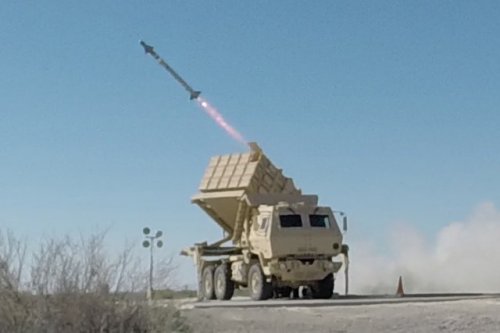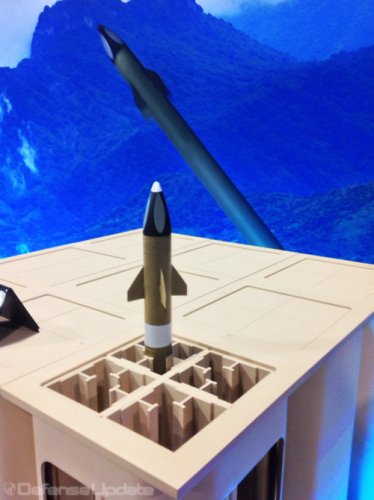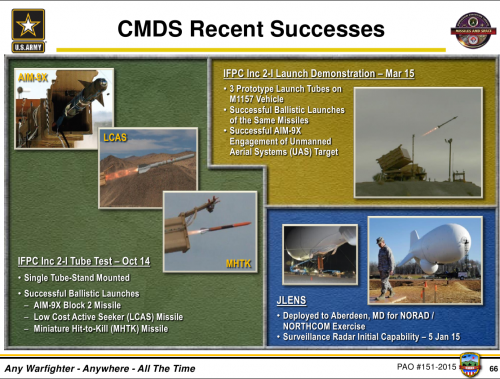bring_it_on
I really should change my personal text
- Joined
- 4 July 2013
- Messages
- 3,651
- Reaction score
- 3,781
Tests begin with interceptors for new base-protection missile shield
Army officials have begun a series of tests to determine the performance of various missiles that could function as interceptors under the service's Indirect Fire Protection Capability Increment 2-Intercept program, the service has announced.
The Army wants to use its existing inventory of munitions as part of the program, developing only a new Multi-Mission Launcher to keep costs down. The effort follows the successful deployment of C-RAM systems -- Counter Rocket, Mortar and Artillery -- to Iraq in previous years. The systems alerted deployed soldiers whenever munitions were flying toward their encampments. Connected to a re-purposed Navy Phalanx gun, the C-RAM setup was able to pulverize munitions in mid-air.
Officials fired a Stinger missile from the MML on March 23, according to a service statement. The test with the man-portable, infrared-homing, surface-to-air missile will be followed by additional shots with other munitions in the coming weeks.
"A variety of other missiles are scheduled to be tested as part of an IFPC Inc 2-I Engineering Demonstration at White Sands Missile Range, NM, in the coming weeks," the Army said.
In addition to the MML, the emerging program will feature connectivity to the Integrated Air and Missile Defense Battle Command System, or IBCS. That system is meant as the Army's brains for virtually all air-defense efforts of the future, netting together optimal sensors and shooters in a given engagement, officials have said.
A Sentinel radar will scan the surroundings for threats. Working in concert, the components are designed to provide spherical coverage.
According to the Army, the new launcher is mounted on a medium tactical vehicle and can rotate 360-degrees. It boasts 15 tubes that can be filled with a single large interceptor or multiple smaller ones.
Col. Terrence Howard, project manager for cruise missile defense systems in the Army's program executive office for missiles and space, told Inside the Army last fall that tests were also planned with the Tamir missile, which is the interceptor for Israel's Iron Dome program.
Additionally, officials want to see how the AIM-9X "Sidewinder," the Miniature Hit-to-Kill missile, and the Hellfire would perform in an IFPC program. The AIM-9X serves as the "reference" missile against which all other interceptors will be compared, Howard said in an interview with ITA at the annual convention of the Association of the United States Army last October.
The goal of the ongoing program tests is to see if the various missile variants can be used against aerial threats like drones and cruise missiles. A later increment of the program will aim to shoot down rockets, artillery and mortar shells with kinetic interceptors or lasers.
Army officials have begun a series of tests to determine the performance of various missiles that could function as interceptors under the service's Indirect Fire Protection Capability Increment 2-Intercept program, the service has announced.
The Army wants to use its existing inventory of munitions as part of the program, developing only a new Multi-Mission Launcher to keep costs down. The effort follows the successful deployment of C-RAM systems -- Counter Rocket, Mortar and Artillery -- to Iraq in previous years. The systems alerted deployed soldiers whenever munitions were flying toward their encampments. Connected to a re-purposed Navy Phalanx gun, the C-RAM setup was able to pulverize munitions in mid-air.
Officials fired a Stinger missile from the MML on March 23, according to a service statement. The test with the man-portable, infrared-homing, surface-to-air missile will be followed by additional shots with other munitions in the coming weeks.
"A variety of other missiles are scheduled to be tested as part of an IFPC Inc 2-I Engineering Demonstration at White Sands Missile Range, NM, in the coming weeks," the Army said.
In addition to the MML, the emerging program will feature connectivity to the Integrated Air and Missile Defense Battle Command System, or IBCS. That system is meant as the Army's brains for virtually all air-defense efforts of the future, netting together optimal sensors and shooters in a given engagement, officials have said.
A Sentinel radar will scan the surroundings for threats. Working in concert, the components are designed to provide spherical coverage.
According to the Army, the new launcher is mounted on a medium tactical vehicle and can rotate 360-degrees. It boasts 15 tubes that can be filled with a single large interceptor or multiple smaller ones.
Col. Terrence Howard, project manager for cruise missile defense systems in the Army's program executive office for missiles and space, told Inside the Army last fall that tests were also planned with the Tamir missile, which is the interceptor for Israel's Iron Dome program.
Additionally, officials want to see how the AIM-9X "Sidewinder," the Miniature Hit-to-Kill missile, and the Hellfire would perform in an IFPC program. The AIM-9X serves as the "reference" missile against which all other interceptors will be compared, Howard said in an interview with ITA at the annual convention of the Association of the United States Army last October.
The goal of the ongoing program tests is to see if the various missile variants can be used against aerial threats like drones and cruise missiles. A later increment of the program will aim to shoot down rockets, artillery and mortar shells with kinetic interceptors or lasers.












